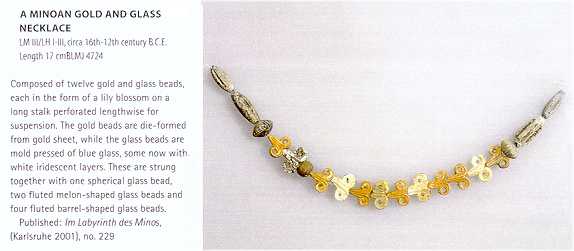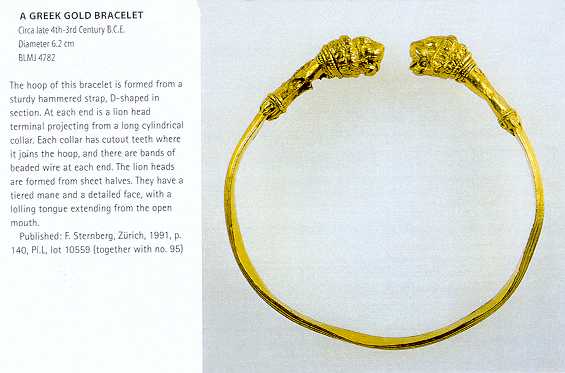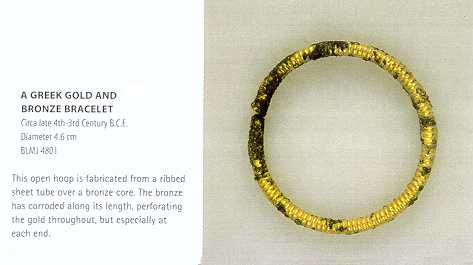
Issue O031 of 1 March 2003
Glories of Ancient Greece Exhibited in Israel
By
Norman A. Rubin
Journalist, Indep. Scholar
Jerusalem, Israel
 The Dr. Eli Borowski collection of exquisite ancient Greek gold jewelry was exhibited (2001-2002) at the Bible Lands Museum in Jerusalem, Israel. The assemblage included earrings, necklaces, wreathes and rings, some which may have been worn by the elite of the society in Ancient Greece.
The Dr. Eli Borowski collection of exquisite ancient Greek gold jewelry was exhibited (2001-2002) at the Bible Lands Museum in Jerusalem, Israel. The assemblage included earrings, necklaces, wreathes and rings, some which may have been worn by the elite of the society in Ancient Greece.
During ancient times, there was an infinite array of jewelry forms that were produced in Greece. Beaded necklaces were often with gold decorative clasps with loops and hooks. Earrings were crafted in the form of hoops with animal heads such as a bull or lion. Bracelets were usually in the form of a snake, coiled in a spiral. Finger rings, both with settings of gold or silver, and inlaid with precious and semi-precious stones, were popular in this era. Hellenistic cameos were also mounted on rings and pendants; these cameo pieces introduced portraiture to glyptic art, inspired by contemporary sculpture and coins. At the same period the goldsmith's repertoire was enriched by exotic motifs such as the Herakles knot (reef knot), the crown of Isis and the crescent.
Gold and silver were highly valued in antiquity from the time that the unique properties of both metals came to be recognized. Eternally attractive to mankind, gold has found its principle use as a metal of value as its beauty has made it popular in decoration. Artifacts of these precious metals were crafted for personal adornment or as magical charms to protect the wearer from deep mysterious powers. Thus both personal embellishment and superstition closely linked the making of jewelry by past civilizations.
Because of its color, gold was associated with the Sun God of pagan religions, who represented sovereignty, wisdom and justice. The royal metal was made into idols, offered to the gods of early civilizations, and was also the adornment of kings and princely consorts (Royal treasures account for the wealth of gold artifacts uncovered in archaeological finds.) whereas silver was the Queen to the King as gold.
"Through Grecian grace you are making your beauty known amoung men." (Talmud Yerushalmi, Megillot 19)
The oldest piece of jewelry in the Borowski collection comes from Crete, dating to the Late Bronze Age. The island of Crete was first in developing a civilization in Europe (the Minoan civilization)(1) which encouraged the fashion for ornamented gold jewelry. The Minoan pendants, rings and earrings had remarkable designs, often based on animal figures, in naturalistic or heraldic style. Necklaces were strung with pendant beans designed in the form of a lily; some of the gold necklaces were interspersed with beaded rock crystals and spherical glass beads in graduated sizes.
At the beginning of the second phase of the Bronze Age (circa 1450 BC), Mycenaeans from the Greek mainland invaded Crete, holding control of the island till the end of that era. Although the Minoan jewelry style continued to flourish, the new style was a fusion of elements: the Minoan love of natural forms and the Mycenaean tendency for stylization and abstraction.
The Late Bronze Age (circa 1600 - 1100 BC) is much richer in jeweled ornaments, especially on the Greek mainland, where the Mycanaean culture came to fulfillment under Cretan influence. Jewelry uncovered in archaeological excavations had been of the highest quality. The principal types were repousse' beads and pendants, the best of them decorated with fine gold filigree, granulation and some with crude blue enamel; and the inlaid gold finger rings set with semi-precious stones or cut colored glass.
Following the destruction of the Mycanaean cities by invading Dorians during the early Iron Age (circa 1100 - 800 BC.) (2) Grecian art reached a low ebb. Jewelry was rare, and the few pieces uncovered at sites consisted of strips of gold wire bent to make finger rings, diadems, earrings or bracelets.
By the 8th century BC when prosperity returned, contacts with the Eastern countries increased bringing new motifs and technology. Such was the term 'granulation' which the ancient Greeks relearned from the Phoenicians. (3) The term 'granulation' refers to the minute gold pellets fused to the metal surface of a piece in an arrangement, which forms the basic design of the ornamentation. Eventually the Mycenaean techniques of filigree, granulation, repousse' and inlay (forgotten during the 400 years of the "Dark Ages" of Dorian conquest) reappear in the crafting of jewelry.
 The Archaic and Classical Periods (4) between the 7th and the 4th cent. BC represent the era of highest achievements in Grecian art, including jewelry. Jewelry was frequently crafted in the shape of miniature figures, birds, animals and mythological scenes of the happy life and adventures of the Greek gods. The Greeks worked chiefly in filigree - gold and silver were shaped in lacelike open work. The ancient Greeks were also masters in art of enamel, which they worked in their jewelry.
The Archaic and Classical Periods (4) between the 7th and the 4th cent. BC represent the era of highest achievements in Grecian art, including jewelry. Jewelry was frequently crafted in the shape of miniature figures, birds, animals and mythological scenes of the happy life and adventures of the Greek gods. The Greeks worked chiefly in filigree - gold and silver were shaped in lacelike open work. The ancient Greeks were also masters in art of enamel, which they worked in their jewelry.
During the Hellenistic period (5), Greek jewelry continued in the classical tradition. Following the successful campaign of Alexander the Great against the Archaemenid Persians, a great quantity of gold and silver booty flowed into Greece. The booty from Alexander's conquest included exquisite jewelry set with precious stones.(6) Around 200 BC Greek artisans emulated this technique. (The brilliant effects of color, attained from the precious and semi-precious stones, tended to substitute for excellence in craftsmanship. Bold relief took the place of fine filigree of earlier days.)
"But the time came when Alexander took to his bed, in the knowledge that he was dying...(1 Macccabees 1:6-7)
After the death of Alexander in 323 BC, Greek kings as well as the wealthy developed a taste for artifacts in gold and silver. During the following period there is an infinite array of jewelry forms. Wreaths and diadems were popular which were most often interred with the dead: Naturalistic flowers and foliage, fabricated from thinly beaten gold were the predominant motifs for diadems of exquisite frailty.
Gold and silver jewelry, some set with precious stones, were highly valued and to own such artifacts was a sign of a person's status, authority or wealth. Thus, splendid pieces have been buried with its wealthy owner preserving its splendor till uncovered by the spade of the archaeologist. The Dr. Eli Borowski collection of ancient Greek jewelry is a showcase to the past "Glories of Ancient Greece".
NOTES
1) Minoan - pertaining to the ancient civilization on the Island of Crete, dating from 3000 to 1100 BC. Lore has it that the Minoans were named after Minos, the legendary king of Knossos.
2) Following the collapse of Mycenaean civilization, jewelry in precious metal is absent on Greek lands for most of the period of the "Dark Ages" of the Dorian conquest.
3) Phoenician craftsmen, including goldsmiths began to settle in Greece in the 8th. century BC.; they opened workshops where their skills were taught to local apprentices.
4) Archaic age (7th to 5th cent and Classical age (5th to 4th) - Are both characterized by the evolution in the structure and simplicity of forms and design in Grecian art. During this period there was an emphasis of the naturalistic human figure in form and anatomical structure in the style of fine arts.
5) Hellenistic Period - Referring to the characteristic of the Ancient Greeks in their thought, culture, custom and arts - After the era of Alexander the Great, from the late 3rd through the 1st century BC.
6) Amethyst was quite popular with the Ancient Greeks as it was acquainted with healing powers of the gods; and those who imbibe liquors to prevent intoxication believed it. They thought sapphire would relieve insanity; topaz could ease asthma; but they were wary of opals as it could bring bad luck.
 FOR MORE INFORMATION
FOR MORE INFORMATION
1) Catalogue of the exhibition "Glories of Ancient Greece" - vases and jewelry from the Borowski collection - Dr. Eli Borowski, curator, Bible Lands Museum\Jerusalem, G. Max Bernheimer, author.
2) Encyclopedia of World Mythology, foreword by Rex Warner.
3) Compact Unabridged Dictionary, Random House, New York.
4) Comptons Interactive Encyclopedia 99
5) "Jewelry", Encyclopedia Britannica
 Back to Cover
Back to Cover
 The Dr. Eli Borowski collection of exquisite ancient Greek gold jewelry was exhibited (2001-2002) at the Bible Lands Museum in Jerusalem, Israel. The assemblage included earrings, necklaces, wreathes and rings, some which may have been worn by the elite of the society in Ancient Greece.
The Dr. Eli Borowski collection of exquisite ancient Greek gold jewelry was exhibited (2001-2002) at the Bible Lands Museum in Jerusalem, Israel. The assemblage included earrings, necklaces, wreathes and rings, some which may have been worn by the elite of the society in Ancient Greece.
 The Archaic and Classical Periods (4) between the 7th and the 4th cent. BC represent the era of highest achievements in Grecian art, including
The Archaic and Classical Periods (4) between the 7th and the 4th cent. BC represent the era of highest achievements in Grecian art, including  FOR MORE INFORMATION
FOR MORE INFORMATION